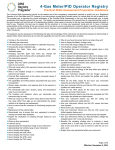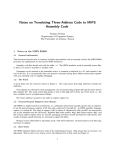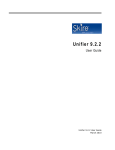Download Compiler Construction - Assignment 4
Transcript
Compiler Construction - Assignment 4 LIACS, Leiden University Fall 2014 Introduction In this assignment we will make a fully functional compiler of the subset Pascal compiler that has been studied in the previous assignments. This means you have to write a code generator unit, which takes the intermediate code and translates this into assembly instructions. In general, these instructions are fed to an assembler, which produces binary code. However, we provide a simulator that can act directly on plain-text assembly. Framework A framework is available for this assignment. To obtain this framework, download assignment4.tar.gz from the practicum website. This directory contains a framework for a subset Pascal compiler. Everything up to and including the intermediate code generation is already filled in; you have to add (naive) MIPS assembly code generation. Build automation is provided; after extracting the framework, first execute ./configure once. To build the entire compiler, simply execute make. Besides the framework, you can find the test cases for this assigment on the practicum website aswell. After decompressing, a directory called tests should be located in a directory where the directory assignment4 is. This allows automated testing by executing the provided script dotests. Data structures The framework of this assignment is an extension to the framework of the previous assignments. You should already be familiar with the data structures that are used for syntax tree construction, symbol table management and intermediate code generation. If not, refer to the documentation of the previous assignment(s). Several new data structures that are needed during the code generation phase are already provided. In the next paragraphs, we briefly describe them. You are not allowed to make any changes to any of the provided data structures, unless stated otherwise. Futhermore, you should avoid triggering warning or error messages from the different object methods. CodeGenerator The CodeGenerator data structure is meant to handle the assembly code generation. You are encouraged to modify and extend this class. By default, the class offers four (almost) empty functions: GenerateHeader(), which should generate a header in the output file; GenerateGlobalDecls(), which should generate the declarations for all global variables that appear in the input program; GenerateCode(), which should perform the actual code generation; and GenerateTrailer(), which should output other information necessary to complete the assembly file. 1 StackFrameManager The StackFrameManager data structure is meant to handle the stack frame related issues of the assembly code generation. You are encouraged to modify and extend this class. In the StackFrameManager.cc file, several function templates are given that might help you in handling stack frames. However, you are also allowed to devise your own mechanism for this. The methods which you have to implement and/or extend are marked with the keyword TODO. To get an overview of all of these locations, you can use the command grep -n TODO *.cc for example. Some examples To give you a better understanding of the desired output, we describe some examples in this section. Consider the following input code (where x & y are global integer variables): if (x = 1) then y := 2 else y := 3; The intermediate code that is generated by the framework will look like the following: # operator | operand1 | operand2 | result ------------------+-------------------+-------------------+------------------0: BNE_I | sym: x | int: 1 | sym: _L1 1: ASSIGN_I | int: 2 | | sym: y 2: GOTO | sym: _L0 | | 3: LABEL | sym: _L1 | | 4: ASSIGN_I | int: 3 | | sym: y 5: LABEL | sym: _L0 | | ------------------+-------------------+-------------------+------------------Corresponding MIPS assembly could look like the following code fragment. For each instruction, the related intermediate statement is indicated. lw addi bne addi sw j _L1: addi sw _L0: $3, $4, $3, $3, $3, _L0 x $0, 1 $4, _L1 $0, 2 y $3, $0, 3 $3, y # # # # # # # # # # statement statement statement statement statement statement statement statement statement statement 0: 0: 0: 1: 1: 2: 3 4: 4: 5 load the value of x into put the value 1 into reg if ($3 != $4) goto _L1 put the value 2 into reg store the value of $3 in goto _L0 reg $3 $4 $3 y put the value 3 into reg $3 store the value of $3 in y As another example, consider a function increase that takes a parameter x, and returns x + 1. A dump of the corresponding intermediate code could look like the following: # operator | operand1 | operand2 | result ------------------+-------------------+-------------------+------------------0: SUBPROG | sym: increase | | 1: ADD_I | sym: x | int: 1 | sym: t1 2: RETURN_I | sym: t1 | | 2 $fp $fp $fp $fp + + - 4 0 4 8 high addresses parameter: x return address previous frame pointer local variable: t1 low addresses Figure 1: The stack frame layout used in our example. Since this is a subprogram, we also need to take care of the activation record (stack frame). In Figure 1, a visual representation of the stack frame is given. In case the subprogram would take more parameters, they would be added at the upper side of the figure, such that address $fp + 8 is assigned to the second parameter , $fp + 12 to the third parameter, etc. This means that the parameters are pushed on the stack in the reverse (right-to-left) order. Additional local variables would appear at the bottom of the figure (with addresses $fp - 12, $fp - 16 etc.). Parameters are pushed on the stack by the caller, and removed from the stack in the epilogue of the callee. All other fields are both pushed and removed by the callee. The following dump shows a possible assembly implementation for the increase function: increase: # Statement 0: Setup the local stack frame (prologue) addi $sp, $sp, -4 # Reserve a stack word sw $31, ($sp) # Save return address addi $sp, $sp, -4 # Reserve a stack word sw $fp, ($sp) # Save current frame pointer addi $fp, $sp, 4 # Make frame pointer point to return address addi $sp, $sp, -4 # Indicate lowerbound of stack frame # Statement 1: The actual body of the function lw $3, 4($fp) # Grab parameter x from the stack addi $3, $3, 1 # Add 1 to it (statement 1) sw $3, -8($fp) # Save it to local variable t1 # Statement 2: Return from the function (epilogue) lw $3, -8($fp) # Load local variable t1 ... add $2, $0, $3 # ... and put it into the return register lw lw addi jr $31, ($fp) $fp, -4($fp) $sp, $sp,16 $31 # # # # Restore the return address Restore the frame pointer Discard stack frame (4 words: x, $31, $fp, t1) Jump back to the caller Now we call this function, using the assignment a := increase(41). Here we assume a is a global variable. The intermediate code could look like the following: 3: PARAM_I | int: 41 | | 4: FUNCCALL | sym: increase | | sym: a ------------------+-------------------+-------------------+------------------This could be translated into the following assembly instructions: addi $3, $0, 41 # statement 3: put the value 41 into reg $3 3 addi sw jal sw $sp, $sp, -4 $3, 0($sp) increase $2, a # # # # statement statement statement statement 3: 3: 4: 4: reserve a stack word store parameter value jump to the function assign return value to a The code examples given in this section are not optimal in terms of execution speed. Assignment What you have to deliver: a compiler which can parse a given code file and translate this into functionally equivalent MIPS assembly that can be simulated on the (X/Qt)SPIM simulator. The GUI version xspim and commandline version spim are installed on the LIACS computers. Another version you might want to consider is QtSPIM, available on http://spimsimulator.sourceforge.net/. The user manual of the SPIM simulator is available on the practicum website. The manual describes the architecture and its instruction set, and gives an overview of the available system calls. You should also provide clear documentation about your implementation decisions. This documentation should be placed in your working directory in the form of a file called DOCUMENTATION.TXT. Furthermore, you have to take a reasonable test case (i.e., a small test case, with recursion, such as recursive Fibonacci number calculation) and explain in detail why the assembly code generated by your compiler is correct for this case. In the framework for this assignment, you receive intermediate code that is similar to the intermediate code you constructed for the previous assignment. Using the classes and methods provided by the framework, you have to step through the intermediate code and write the resulting assembly to a file. The generated assembly code does not have to be efficient. You may, however, receive a higher grade if you optimize the usage of the registers. Doing so, you might reduce the number of loads and stores needed. Submissions without optimizations may yield a grade of 9 as a maximum. If you implement (many) optimizations, the maximum grade will be 10 as usual. Some other notes: • In this and the following assignment, we use call-by-value parameter passing. • You can assume that the input for the code generation phase is correct. This means that you do not have to write code that verifies if the intermediate code is correct. • A register usage convention exists for the MIPS architecture (e.g., R4 - R7 are reserved for the first four actual parameters of a function call). However, you do not have to respect this convention, since it would make this assignment considerably more complicated. For example, for integer values, you can just use any of the registers R3 - R25. • For the real data type, use 32-bit single precision floating point arithmetic. • Although it is not in the manual, you may use the li.s instruction to load a floating point immediate. • In the file main.cc, some other functions are available, that you may need during this assignment (e.g., the IsGlobal function, which determines whether a symbol is a global variable or not). • No memory leaks should occur in your code. Submission & Grading To submit your work, cd into your assignment directory and prepare a .tgz file as follows: make clean (you may need to perform additional cleaning) 4 cd .. tar -cvzf your names here.tgz assignmentX Send this .tgz file by email to Mathijs van de Nes ([email protected]). Only send your source code, do not send executables or extra object files. Your work should be received before December 8, 2013 at 23:59. For this assignment, 0-10 points can be obtained, which account for 33% of your lab grade. If you do not submit your work in time, it will not be graded. Plagiarism in your submission is strictly forbidden and will immediately lead to a 0 grade if detected. Your grade for the assignment will not only depend on the functionality of your compiler, but also on the understandability of your code and the documentation of the design decisions. Documentation should be submitted in English only. All code must be able to compile on the Linux operating system at LIACS. We may invite students to elaborate on their submission. For this task, there will be 2 (academic) hours of lab-session. Outside of these hours, you can contact Mathijs van de Nes ([email protected]) in case of questions. 5




















